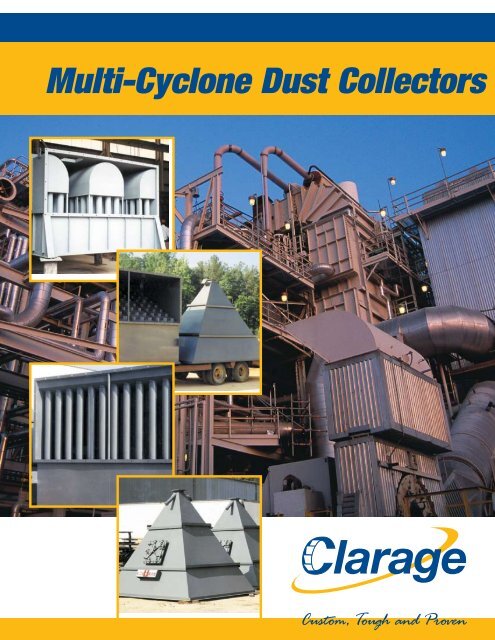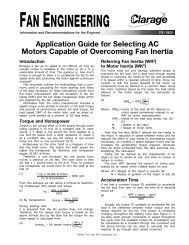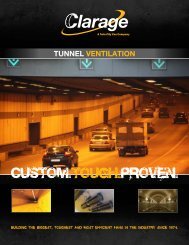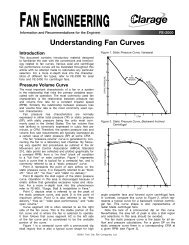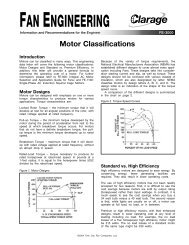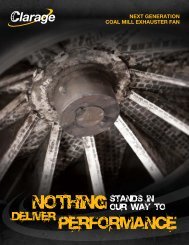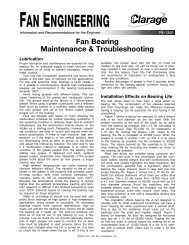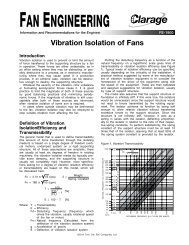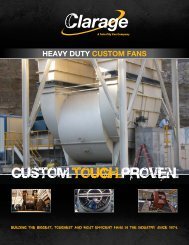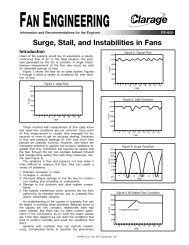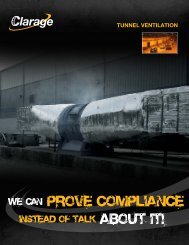Multi-Cyclone Dust Collectors - Clarage
Multi-Cyclone Dust Collectors - Clarage
Multi-Cyclone Dust Collectors - Clarage
You also want an ePaper? Increase the reach of your titles
YUMPU automatically turns print PDFs into web optimized ePapers that Google loves.
<strong>Multi</strong>-<strong>Cyclone</strong> <strong>Dust</strong> <strong>Collectors</strong>
<strong>Clarage</strong><br />
Half a Century of<br />
Design and Experience<br />
Designed and Fabricated<br />
to Meet Customer Needs<br />
CLArAge MuLti-CyCLone<br />
MeCHAniCAL CoLLeCtorS<br />
Experience makes the difference.<br />
<strong>Clarage</strong> has been in business<br />
since 1874, dedicated to the design<br />
and fabrication of fans since 1912<br />
and mechanical multi-cyclone dust<br />
collectors since 1940. When <strong>Clarage</strong><br />
collectors were first introduced, it<br />
was under the name of the Fly Ash<br />
Arrestor Corporation. In the late<br />
1960’s, the name changed to Zurn<br />
Air Systems Division, and in 1997<br />
our current name, <strong>Clarage</strong> was<br />
introduced. Although the name<br />
has changed, <strong>Clarage</strong> still<br />
manufactures mechanical collector<br />
equipment that has established<br />
one of the best known and widely<br />
respected reputations in the world.<br />
There are thousands of <strong>Clarage</strong> collectors<br />
installed in the United States and<br />
around the world. <strong>Clarage</strong>'s experience,<br />
capability, and extensive installation<br />
list has been built up over decades<br />
of dedication and resourcefulness.<br />
Practical uses for <strong>Clarage</strong> collectors<br />
range from helping a system meet its<br />
required air quality emission levels,<br />
to extending the life of the system<br />
ID Fan and connecting ductwork.<br />
Specific applications <strong>Clarage</strong> has<br />
supplied collectors for include:<br />
Oil<br />
Rockwool<br />
Bagasse<br />
Lime dust<br />
Glass beads<br />
Sludge<br />
Coke calciner<br />
Sulfur dust<br />
Sinter dust<br />
Feldspar<br />
Clinker cooler dust<br />
Iron ore pellets/dust<br />
Kalor dust<br />
Rice hulls<br />
Petroleum coke<br />
Sulfite<br />
Wood waste/bark (various types)<br />
Coal (various types)<br />
Miscellaneous refuse<br />
Unmatched experience along with<br />
flexible engineering and the capability<br />
of altering conventional designs to<br />
meet specific customer needs, makes<br />
<strong>Clarage</strong> the best choice for mechanical<br />
collectors.
<strong>Clarage</strong> <strong>Collectors</strong><br />
the <strong>Multi</strong>-<strong>Cyclone</strong><br />
Mechanical Collector<br />
A collector consists of a housing<br />
containing a quantity of collecting<br />
tube assemblies, each an individual<br />
centrifugal dust collector. As illustrated,<br />
dust laden gas enters the top of<br />
the collecting tube through the inlet<br />
guide vanes. These vanes impart a<br />
smooth, fast spiral to the gas, setting<br />
up a highly centrifugal action with a<br />
minimum of turbulence and erosion.<br />
As the gas descends in a cyclonic pattern,<br />
the dust is forced by centrifugal<br />
action against the wall of the collecting<br />
tube and gravitates to the bottom<br />
where it is discharged through the<br />
dust discharge boot. A vortex forms at<br />
the bottom of the collecting tube and<br />
the cleaned gas makes an inner whirl<br />
up into the outlet tube. Optional outlet<br />
recovery vanes help straighten the gas<br />
flow to reduce draft loss.<br />
Careful attention to housing design<br />
details such as inlet and outlet proportions,<br />
collecting tube spacing, and<br />
dust discharge boot design assures<br />
uniform gas distribution and proper<br />
flow to each individual collecting tube<br />
for maximum design efficiency.<br />
tube Diameters and<br />
efficiency<br />
<strong>Clarage</strong> collectors are available with<br />
6", 9" and 11.5" diameter collection<br />
tubes. Theoretically, high-collection<br />
efficiencies are achieved with the<br />
smaller 6" or 9" diameter tubes, since<br />
the centrifugal force applied to the<br />
dust particles increases as the tube<br />
diameter decreases. Three other<br />
major design factors also significantly<br />
affect collection efficiency, namely<br />
proper gas distribution, draft loss, and<br />
particle size/specific gravity. <strong>Clarage</strong><br />
engineering is available for assistance<br />
in determining tube size.<br />
Standard (StD) and<br />
totally Accessible<br />
(tA) Mechanical<br />
<strong>Collectors</strong><br />
<strong>Clarage</strong> collectors are designed and<br />
fabricated to meet the customers<br />
needs. The two types available are<br />
Standard (STD) and Totally<br />
Accessible (TA).<br />
The collecting tube assemblies for<br />
both the STD and the TA collectors<br />
are identical. The differences between<br />
the STD and the TA collector are<br />
in the design of the housings and<br />
outlet tubes.<br />
Operation of collecting tube assembly.
Standard Design<br />
Collector<br />
…when space is a<br />
premium.<br />
Totally Accessible<br />
Design Collector<br />
…when total access is<br />
required.<br />
StAnDArD DeSign CoLLeCtor<br />
T he STD design collector is most commonly used<br />
in smaller industrial applications. The greatest<br />
advantage of the STD collector is its compact design that<br />
can easily accommodate space limitations. Additional<br />
advantages of the STD collector design can be realized<br />
through cost reduction in insulation and lagging area,<br />
as well as a smaller support structure.<br />
Standard Collector<br />
Features:<br />
Available in Three Tube Sizes<br />
Collecting tubes in 6", 9" and 11.5"<br />
diameters available to meet individual<br />
requirements.<br />
Heavy-Duty Construction<br />
All components are designed for rugged<br />
service by an experienced collector<br />
team totally familiar with collector<br />
operation. Each application is individually<br />
evaluated based on the severity of<br />
service and previous field experience.<br />
Completely Shop-Assembled<br />
All collectors are custom-fabricated<br />
and completely assembled to the extent<br />
practical for shipment. This results<br />
in minimum erection man-hours and<br />
handling at the installation site.<br />
Cast Collecting Tubes<br />
Special cast tubes give uniform wall<br />
thickness and maximum Brinell<br />
hardness for prolonged service-life.<br />
The mounting flange at the top of the<br />
collecting tube is an integral part of<br />
the casting. Four studs provide secure,<br />
gas-tight mounting.<br />
Replaceable <strong>Dust</strong> Discharge Boots<br />
Sturdy cast iron boots are at the<br />
base of the collecting tubes where<br />
the greatest wear occurs. Each boot<br />
bolts in place for quick, economical<br />
replacement compared to more costly<br />
tube designs which utilize an integral<br />
tube bottom.<br />
Access Doors<br />
This feature is constructed of heavy<br />
duty cast iron with quick open design,<br />
that requires no special tools to open.<br />
These doors can be located in any<br />
direction. Special configuration such<br />
as our “Double-Doors” can be incorporated<br />
at the customers request.<br />
Warning signs and safety chains<br />
are always standard components of<br />
<strong>Clarage</strong> Collector Access Doors.
<strong>Clarage</strong> <strong>Collectors</strong><br />
totALLy ACCeSSibLe DeSign CoLLeCtor<br />
The TA collector offers three basic differences to<br />
conventional standard collector designs. These<br />
result in significant improvements in collector wearresistance<br />
and maintenance. These differences are:<br />
• Grouped collecting tubes with inlet access corridors<br />
• Separate outlet plenums for tube groupings<br />
• Equal length outlet tubes<br />
The inlet access is such that every tube is within easy<br />
reach and view. Normal design provides that no tube<br />
is more than one tube away from the access corridor,<br />
making it totally accessible.<br />
totally Accessible<br />
Collector Features:<br />
Totally Accessible <strong>Collectors</strong> have<br />
all of the features of the Standard<br />
Collector, and the following additional<br />
features:<br />
Totally Accessible<br />
The accessibility is available through<br />
access doors provided at both inlet<br />
and outlet locations for inspection,<br />
cleaning and maintenance as required.<br />
Lower Velocities<br />
Lower velocities significantly reduce<br />
the wear of the tube assembly components.<br />
Entering gases/particulate<br />
utilize the access corridors, therefore<br />
do not cause abrasion while passing<br />
through the array of gas outlet tubes,<br />
which is common to conventional<br />
collectors.<br />
Flexible Arrangement<br />
TA collectors, with no inlet static<br />
pressure differential, make long and<br />
narrow arrangements possible for<br />
substantial duct savings. The unique<br />
TA design also allows flexibility in<br />
inlet and outlet arrangements.<br />
Elimination of Hopper<br />
Recirculation<br />
The TA collector does not have differential<br />
pressure in the hopper, thereby<br />
eliminating the problem of hopper<br />
recirculation.<br />
Balance Flow To All Tubes<br />
The plenum hooded design eliminates<br />
obstruction in the gas stream as the gas<br />
travels through the collector assembly.<br />
This non-obstructive feature allows<br />
for no inlet static pressure differential,<br />
and provides low-velocity/low-pressure<br />
drop gas flow to every tube.<br />
oPtionAL StD AnD tA<br />
DeSign FeAtureS<br />
Hopper Evacuation Systems<br />
Inlet/Outlet Arrangements<br />
Damper Control for<br />
Increased Collector Flexibility<br />
• Sectionalizing<br />
• By-Pass<br />
• Isolation
<strong>Clarage</strong><br />
(6) OUTLET TUBE<br />
(Constant length for Totally<br />
Accessible <strong>Collectors</strong>;<br />
variable length for<br />
Standard <strong>Collectors</strong>)<br />
(3) SEAL<br />
(Airtight)<br />
(5) INLET<br />
GUIDE<br />
VANES<br />
(8) BOOT<br />
STRAP<br />
(7) DUST<br />
DISCHARGE<br />
BOOT<br />
Cut-away View of the<br />
Inlet Tube Assembly<br />
(10) TOP TUBE SHEET<br />
(Sloped in Standard <strong>Collectors</strong>)<br />
(2) BOTTOM<br />
TUBE SHEET<br />
(4) STUD<br />
(9) OPTIONAL<br />
OUTLET<br />
RECOVERY<br />
VANES<br />
(1) CAST INLET<br />
COLLECTING<br />
TUBE<br />
your SingLe SourCe For ALL<br />
CoLLeCtor rePLACeMent PArtS<br />
<strong>Clarage</strong>’s expertise certainly does<br />
not end with the design and<br />
fabrication of our own collectors.<br />
One <strong>Clarage</strong>'s greatest strengths has<br />
been, and continues to be, the ability<br />
to repair, modify, or replace other<br />
manufacturer’s collectors. Replacing<br />
obsolete equipment produced by<br />
companies like Western, Joy, UOP,<br />
etc. is routine and common practice<br />
at <strong>Clarage</strong>. Engineering flexibility, in<br />
most cases, allows <strong>Clarage</strong> to match<br />
existing collector dimensions exactly.<br />
This results in lower replacement<br />
costs, through fewer modifications to<br />
the surrounding structures.<br />
Even when only replacement tubes<br />
are required, <strong>Clarage</strong> is the logical<br />
choice. Most competitor tube assembly<br />
designs (obsolete and current),<br />
can be easily substituted with one<br />
of <strong>Clarage</strong>’s available tube sizes.<br />
Over the years, the 9" inlet tube has<br />
become the most universally used<br />
tube size for Mechanical <strong>Collectors</strong>.<br />
<strong>Clarage</strong> offers this size, and is able to<br />
adapt it to any collector design which<br />
uses the 9" tube. This ability, along<br />
with an always adequately stocked<br />
supply of collector parts, makes<br />
<strong>Clarage</strong> the best choice.<br />
Whether it’s a single part or the entire<br />
unit, <strong>Clarage</strong> has your mechanical collector<br />
replacement part needs covered.<br />
Cast inlet Collecting<br />
tubes With integral<br />
Mounting Flange<br />
<strong>Clarage</strong> collecting tubes (1) are<br />
constructed of cast iron with an alloy<br />
additive to yield a higher Brinell<br />
hardness.<br />
A mounting flange is cast at the top<br />
of the collecting tube, which holds the<br />
entire assembly to the bottom tube<br />
sheet (2). A permanent airtight seal<br />
(high temp. gasket) (3) is required to<br />
prevent gas from escaping around<br />
the tube directly into the hopper.<br />
A 3/8-inch lip extends above the<br />
integral flange to extend through the<br />
tube sheet into the inlet. The flange<br />
is sealed to the tube sheet with four<br />
studs (4) to retain the initial tight-seal<br />
even under severe service.
<strong>Clarage</strong> <strong>Collectors</strong><br />
inlet guide vanes<br />
The inlet guide vanes (5) are separately<br />
cast and are held in place by support<br />
on the gas outlet tube (6). They fit<br />
securely in place inside the collecting<br />
tube keeping the outlet tube centered.<br />
Inlet guide vanes are designed to give<br />
the gas maximum centrifugal action<br />
on its spiraling path down the tube<br />
toward the dust discharge boot (7).<br />
Inlet guide vanes are replaceable by<br />
splitting them in half. Each vane has<br />
two notches for this purpose.<br />
<strong>Dust</strong> Discharge boot<br />
The cast-iron dust discharge boot is<br />
retained at the lower end of the collecting<br />
tube by two boot straps (8).<br />
The boot straps in turn are bolted in<br />
place at the top of the collecting tube<br />
with two of the studs used to connect<br />
the assembly to the bottom tube<br />
sheets. Since the boot is subject to<br />
the greatest wear, it has been designed<br />
for easy replacement. This design<br />
allows greater cost savings than<br />
replacement of the entire collecting<br />
tube, as with competitive designs having<br />
the boot and tube as an integral<br />
assembly. The dust discharge boot has<br />
three peripheral slots where collected<br />
dust is discharged by inertial and<br />
centrifugal force out of the tube,<br />
immediately prior to the vortex<br />
reversal of the gas at the tube bottom.<br />
outlet recovery<br />
vanes<br />
Recovery vanes (9) are used at the<br />
lower end of the gas outlet tube in<br />
certain applications. These vanes are<br />
used to recover the rotational energy<br />
of the exiting gas, thereby increasing<br />
the total capacity of each collecting<br />
tube. Recovery vanes are not recommended<br />
where the incoming gas has<br />
a characteristic, such as heavy oil<br />
or bark-fired combinations. Outlet<br />
recovery vanes have the efficiency<br />
benefits of permitting a smaller<br />
collector for a given gas flow.<br />
outlet tubes<br />
Example of “STD” Type collector modified to<br />
incorporate “TA” Type structural supports, and<br />
angle iron wear shields on the front row of<br />
outlet tubes.<br />
Outlet tubes are held in place at the<br />
lower end by the inlet guide vane<br />
and welded at the top to the top<br />
tube sheet (10). Their purpose is to<br />
deliver the cleaned gas from the collecting<br />
tubes to the outlet chamber.<br />
The abrasive gases on the outside of<br />
these tubes cause greater wear than<br />
from the inside. Both steel and high-<br />
Brinell cast outlet tubes are available.<br />
The unique design of the<br />
discharge boot means<br />
low cost replacement<br />
with improved<br />
operating efficiency.
<strong>Clarage</strong><br />
ProDuCtS AnD ServiCeS<br />
Standard<br />
Centrifugal Fans<br />
Backward Curved<br />
Backward Inclined<br />
Pressure Blower<br />
Industrial Exhauster — Radial/<br />
Paddle Wheel<br />
Cast Iron Exhauster<br />
Custom<br />
Centrifugal Fans<br />
Airfoil<br />
Backward Curved<br />
Backward Inclined<br />
Radial Tip<br />
Straight Radial<br />
Forward Curved<br />
Hi-Boost — 2-Stage<br />
Pressure Blowers<br />
All Drive Arrangements<br />
SWSI and DWDI Selections<br />
Inlet Boxes<br />
Sleeve or Anti-friction Bearings<br />
Volume Control Dampers<br />
High Temperature Fans<br />
Special Materials<br />
5030 - June 2003<br />
Axial Fans<br />
Jet Fans<br />
Tubeaxial<br />
Vaneaxial<br />
Fixed Pitch<br />
Adjustable Pitch — In Motion<br />
Adjustable Pitch — At Rest<br />
<strong>Multi</strong>-<strong>Cyclone</strong><br />
<strong>Dust</strong> <strong>Collectors</strong><br />
6", 9" and 11.5" Tube<br />
Availability<br />
Standard (STD) and Totally (TA)<br />
Accessible Designs<br />
5959 trenton Lane<br />
Minneapolis, Mn 55442<br />
24-Hour emergency Service Hotline<br />
800-598-9234<br />
Phone 763-551-7600<br />
Fax 763-551-7601<br />
www.clarage.com<br />
sales@clarage.com<br />
Services<br />
Repair and Rebuild<br />
Field Service<br />
Upgrade Engineering<br />
• Performance<br />
• Material Construction<br />
Quality Fabrication<br />
Erection and Start-up<br />
Supervision<br />
Testing Services<br />
Turnkey Services<br />
ISO 9001<br />
CERTIFIED


